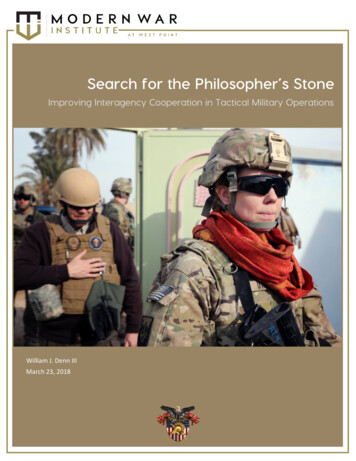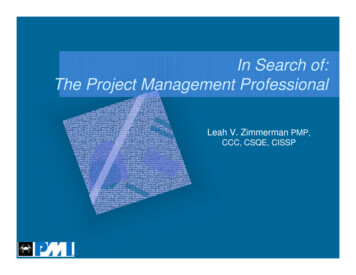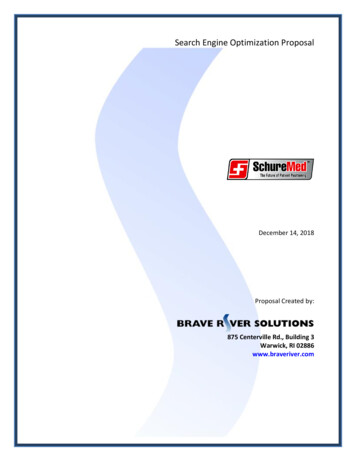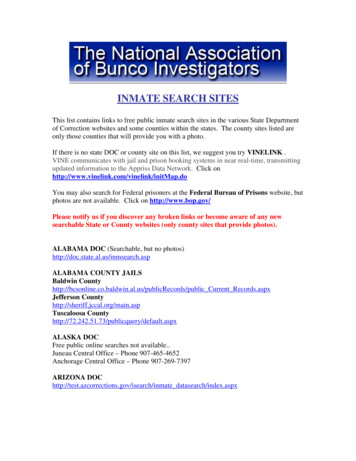
Transcription
Search for the Philosopher’s StoneImproving Interagency Cooperation in Tactical Military OperationsWilliam J. Denn IIIMarch 23, 2018
Search for the Philosopher’s Stone: Improving Interagency Cooperation in Tactical Military OperationsMaj. William Denn, originally from Albany, NY, commissioned into the United StatesArmy through the US Military Academy at West Point in 2006 with a Bachelor ofScience Degree in International Relations and Systems Engineering. He led both tankand infantry platoons in Iraq fighting alongside the Kurdish Peshmerga in Mosul from2007 to 2009. In 2010, as an intelligence officer, he served as a Combat Advisor to theAfghan Security Forces in Regional Command East, Afghanistan.Following his tour in Afghanistan, Denn developed new efforts to bridge gaps between nationalintelligence and the deployed tactical warfighters at the National Security Agency. After commanding amilitary intelligence company, Denn completed his Master in Public Policy at Harvard’s Kennedy Schooland graduated as the honor graduate of the US Army Command and General Staff College. Following theStaff College, Denn completed the US Army’s School of Advanced Military Studies where he studied tobecome a war planner. Denn is currently a planner at the 82nd Airborne Division at Fort Bragg, NC.Denn has written for the Washington Post, the Boston Herald, and several policy and military journals. Hehas published on a variety of topics to include interagency integration into military operations, civilmilitary relations, counterinsurgency and security force assistance, and leadership studies. He is arecipient of the General Douglas MacArthur Leadership Award and the General George C. Marshall Award.He is a member of the board of directors of the Council on Emerging National Security Affairs.
Search for the Philosopher’s Stone: Improving Interagency Cooperation in Tactical Military OperationsTable of ContentsAbstract . 1Acronyms . 3Figures. 5Tables . 7Introduction . 9Research Questions and Methodology . 12A Discussion on Bureaucracy . 15Necessary Characteristics of Interagency Cooperation . 18Competing Ideas Addressing Insufficient Stability Expertise . 19Analytical Model . 20Case Studies . 23Case Study 1: Africa Command Regionally Aligned Forces . 23Regionally Aligned Forces Interagency Problems . 26Measuring the Effectiveness of Regionally Aligned Forces . 30Summary Analysis of Regionally Aligned Forces Case Study . 31Case Study 2: US Response to Ebola in West Africa . 32International Community Rallies for Action . 32Ebola: A Model for Interagency . 34Measuring the Effectiveness of Interagency Integration during the Ebola Crisis . 35Summary Analysis of Ebola Case Study . 40Case Study Summaries . 40Conclusions and Recommendations . 43Recommendations . 44Doctrine: Update Military Doctrine on Interagency Tools . 45Organization: Reform the Civil-Military Operations Center . 45Training: Improve Interagency Training within the Military . 46Policy: Build Greater Capacity for Deployable Civilians in DoS and USAID . 46Recommendations for Future Research . 47Closing Thoughts . 47Appendix A: Interagency Cooperation Embedded in US Army and Joint Doctrine . 49Types of Interagency Cooperation Embedded in Current Doctrine . 49Appendix B: At What Level Does Interagency Integration Currently Occur?. 53Interagency Personnel Management in Support of Stability Operations . 57Bibliography. 59
Search for the Philosopher’s Stone: Improving Interagency Cooperation in Tactical Military OperationsAbstractThe United States National Security Strategy and Department of Defense (DoD) joint doctrine recognizesthat the complexity of the contemporary operational environment requires the United States to pursuewhole-of-government solutions that integrate civil-military interagency cooperation. In particular, themilitary requires the expertise of interagency partners in stability operations. Army doctrine recognizesthat interagency synchronization occurs at all echelons, although it has yet to fully institutionalizeinteragency integration at tactical levels. This paper examines two historical case studies whereinteragency integration was essential to tactical mission success: DoD—Interagency response to Ebola inWest Africa, and DoD—Interagency coordination for Africa Command (AFRICOM) Regionally AlignedForces (RAF). The conditions that led to successful implementation of these programs are highlighted withan analysis across a Doctrine, Organization, Training, Materiel, Leadership-Education, Personnel, Facilities,and Policy (DOTMLPF) framework. Both case studies provide valuable lessons on how the United StatesArmy may better integrate interagency at the tactical level of stability operations. The author based onhis analysis also proposes several recommendations across the DOTMLPF framework for more effectiveinteragency integration in future DOD tactical operations.1
Search for the Philosopher’s Stone: Improving Interagency Cooperation in Tactical Military OperationsAcronymsAARAfter Action ReportAFRICOMAfrica Command (United States)AOCArmy Operating ConceptBCTBrigade Combat TeamCMOCCivil-Military Operations CenterCOCOMCombatant CommandDARTDisaster Assistance Response TeamDoDDepartment of Defense (United States)DoSDepartment of State (United States)DOTMLPF-PDoctrine, Organization, Training, Materiel, Leadership/Education, Personnel, Facilities,and PolicyGAOGovernment Accountability Office (United States)HA/DRHumanitarian Assistance/Disaster ReliefHQHeadquartersJFCJoint Forces CommandJIACGJoint Interagency Coordination GroupJIATFJoint Interagency Task ForceJIIMJoint, Interagency, Interorganizational, MultinationalJPJoint PublicationJTFJoint Task ForceLNOLiaison OfficerMCTPMission Command Training ProgramMoHLiberian Ministry of HealthNECCNational Ebola Coordination CenterNGONongovernmental OrganizationNSCNational Security CouncilNSPNational Solidarity ProgramPRTProvincial Reconstruction TeamRAFRegionally Aligned ForcesUSAIDUS Agency for International DevelopmentUSARAFUS Army Africa3
Search for the Philosopher’s Stone: Improving Interagency Cooperation in Tactical Military OperationsUSDAUS Department of AgricultureUSGUS GovernmentUNUnited NationsWHOWorld Health Organization4
Search for the Philosopher’s Stone: Improving Interagency Cooperation in Tactical Military OperationsFiguresFigure 1: Example AFRICOM RAF Security Cooperation Activities . 26Figure 2: AFRICOM’s Fragmented Coordination . 29Figure 3: Ebola Cumulative Incidence—West Africa, September 20, 2014 . 33Figure 4: Unity of Effort Approaches to Stability . 51Figure 5: Relationship of JIACG with NSC . 54Figure 6: JIACG Structure and Functions. 555
Search for the Philosopher’s Stone: Improving Interagency Cooperation in Tactical Military OperationsTablesTable 1: Program—Primary Research Question Analysis . 21Table 2: Program—Analytical Lens . 21Table 3: DOTMLPF-P Analysis of RAF Interagency Case Study . 31Table 4: Cumulative Reported Ebola Cases: Guinea, Liberia, and Sierra Leone . 32Table 5: DOTMLPF-P Analysis of Ebola Case Study . 407
Search for the Philosopher’s Stone: Improving Interagency Cooperation in Tactical Military OperationsIntroductionThe Army of 2025 and Beyond will effectively employ lethal and non-lethal overmatch against anyadversary to prevent, shape, and win conflicts and achieve national interests. It will leveragecross-cultural and regional experts to operate among populations, promote regional security, andbe interoperable with the other Military Services, United States Government agencies and alliedand partner nations.— Combined Arms Center, The Army Vision:Strategic Advantage in a Complex WorldOver a decade ago, the stability and reconstruction missions of Iraq and Afghanistan revealed criticalcapability gaps within the US military. The military, while conducting combat operations against al-Qaedaand the Taliban, was also simultaneously conducting stability operations—development, governance,rule-of-law promotion, conflict resolution, and similar activities—at the local level with little guidance andoversight. While young leaders at the tactical and local level admirably sought to conduct these stabilityoperations, the reality showed that the military was untrained, was unequipped, and lacked the expertiseto effectively manage governance, development, rule-of-law promotion, and conflict resolution on thebattlefield.At the tactical level, the frustration was common among young lieutenants and captains, who, asnominal mayors of villages and towns, were expected to restore vital civil services and negotiate andresolve conflicts among feuding factions. The result was a “bipolar disorder” of sorts, as leaders plannedhigh-value targeting raids one day; negotiated contracting issues with local firms the next day; conductedsewage, water, and educational assessments the next; and then ran microcredit grant programs the next.Our military training system mostly taught conventional kinetic operations; much of the nonkineticstability requirements were on-the-job or figure-it-out learning in theater.The challenges in stability operations faced by the Department of Defense (DoD) were highlightedby the US special inspector general for Afghanistan reconstruction, who noted that DoD’s efforts to sparkthe country’s economic development, which cost between 700 million and 800 million, “accomplishednothing.” The Task Force for Business and Stability Operations—a DoD unit aimed at developing war zonemining, facilitating industrial development, and fostering private investments—was considered by thespecial inspector general for Afghanistan reconstruction as “an abysmal failure,” lacking leadership, anyclear strategy, or accountability. 11Gould, “SIGAR.”9
Search for the Philosopher’s Stone: Improving Interagency Cooperation in Tactical Military OperationsThese challenges at both the tactical and operational level are an indicator that the US militarylacked the capacity and expertise to accomplish inherently nonmilitary tasks related to stability and nationbuilding. Assuming that the expertise to do some of these tasks existed within the US government (USG),or could have been contracted by the USG, why could the military not better leverage that expertise tomore effectively guide the accomplishment of the stability tasks associated with our nation building andcounterinsurgency operations?Despite the conflicts of Iraq and Afghanistan being national priorities requiring a comprehensive,whole-of-government civil-military strategy, the US military was required to do more than the lion’s shareof lifting precisely because it was the only USG organization with the manpower and capacity to deploy inan expeditionary manner. With a lack of large-scale interagency presence and with limited means tocoordinate with the interagency, military battlefield commanders were often in the lead to plan andexecute stability operations within their area of operations. These nonmilitary tasks inherently becamemilitary tasks—and despite a can-do attitude, many of these efforts failed due to a lack of expertise. Butdespite recognition from the military that they were often ill equipped for this type of mission, theproblem continued because of a civilian interagency apparatus that was simply ill prepared and illresourced to manage or coordinate with the military for these nation-building tasks for the scope andmagnitude necessary.Over the course of the conflicts in Iraq and Afghanistan, interagency integration improved as theUSG surged civilian experts to advise battlefield commanders in governance and development activities.However, rather than institutionalize much of this interagency cooperation for future conflicts, much ofit remains ad hoc in nature, created only for the conflicts at hand.To be clear, the purpose of this report is not to reexamine the failures in Iraq and Afghanistan butrather to look toward the future and examine how to structure tactical formations better equipped tohandle the types of complicated and complex environments that we anticipate. In part, the US Armyrecognizes that interagency integration is crucial to future success. The version of Army DoctrinePublication (ADP) 3-0, Unified Land Operations, published in 2011 (after nearly a decade of fighting in Iraqand Afghanistan) described the critical nature of interagency cooperation:Army forces operate as part of a larger national effort characterized as unified action. Armyleaders must integrate their actions and operations within this larger framework, collaboratingwith entities outside their direct control. All echelons are required to incorporate suchintegration. . . . Effective unified action requires Army leaders who can understand, influence,and cooperate with unified action partners. The Army depends on its joint partners forcapabilities that do not reside within the Army, and it cannot operate effectively without their10
Search for the Philosopher’s Stone: Improving Interagency Cooperation in Tactical Military Operationssupport. Likewise, government agencies outside the Department of Defense possess knowledge,skills, and capabilities necessary for success. The active cooperation of partners often allowsArmy leaders to capitalize on organizational strengths while offsetting weaknesses. Only bycreating a shared understanding and purpose through collaboration with all elements of thefriendly force—a key element of mission command—can Army leaders integrate their actionswithin unified action and synchronize their own operations. 2Inherent in this statement is a doctrinal recognition that Army operations are part of a broadernational effort—“unified action”—that requires the expertise of interagency partners. Without thecollaboration, integration, and synchronization with these partners at all echelons, the Army cannotoperate effectively.This discussion highlights three fundamental observations:1. There exists a tremendous capability gap in US military formations to execute stability tasks,particularly ones focused on governance and development.2. USG civilian agencies (including those at the state and local level) may have valuable expertiseand capacity that could be leveraged in future stability operations to enhance the military’sunderstanding of the operational environment, as well as accomplish stability tasks andobjectives.3. The future of military operations will still have a large component of stability operations requiringlocal and regional knowledge, cultural understanding, and technical and specialized expertise.Today, the status of DoD and interagency integration, particularly with the Department of State(DoS) and the US Agency for International Development (USAID), faces additional challenges. Agencieslike DoS currently face major budgetary cuts of up to 30 percent, which will reduce their capacity toconduct expeditionary diplomacy in the future. 3 Concern over these proposed budgetary cuts was so largethat in February 2017 more than 120 retired three- and four-star generals and admirals sent a letter tothe House and Senate leadership in order to advocate for protecting the DoS budget. They wrote, “TheState Department, USAID, Millennium Challenge Corporation, Peace Corps and other developmentagencies are critical to preventing conflict and reducing the need to put our men and women in uniformin harm’s way. . . . The military will lead the fight against terrorism on the battlefield, but it needs strong2Headquarters, Department of the Army, Unified Land Operations, 3.3Krieg and Mullery, “Trump’s Budget by the Numbers.”11
Search for the Philosopher’s Stone: Improving Interagency Cooperation in Tactical Military Operationscivilian partners in the battle against the drivers of extremism—lack of opportunity, insecurity, injustice,and hopelessness.” 4A consequence of these budgetary cuts will be further challenges to the integration of interagencypa
Science Degree in International Relations and Systems Engineering. He led both tank and infantry pl atoons in Iraq fighting alongside the Kurdish Peshmerga in Mosul from 2007 to 2009. In 2010, as an intelligence officer , he served as a Combat Advisor to the Afgh











